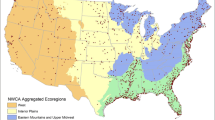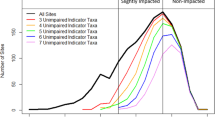Abstract
The planning and execution of water quality management programs requires careful collection and analysis of data coupled with a systematic review and analysis of programmatic success. The environmental audit is a tool which facilitates improved water quality planning and management. This article demonstrates the utility of the environmental audit by reviewing portions of a comprehensive review of the water quality management program for the state of Idaho. The audit is a tool which forces careful design of a sampling program before data are collected. In the audit approach, program objectives are clearly stated prior to initiation of sampling. Stated objectives are also evaluated regularly to identify tension points, that is, conflicts between expectations and reality. In the example taken from Idaho, a management review team followed a directive to redesign the water quality monitoring program. We present a summary of the redesign as proposed by that team, to illustrate the results of a typical review of monitoring programs. That summary is followed by an example of how the proposed program would differ if the audit approach had been used. The two approaches offered both coincident and conflicting recommendations. Management review team and audit recommendations for lake sampling programs were similar even though a different process was used to develop the recommendations. The most striking contrast between the two results lies in the review team's approach to the problem. The directives followed, and the team's responses, concentrate on tools, such as increasing biological monitoring or reliance on monthly BWMP stations. In contrast, the audit results stress addressing management questions for which clear objectives have been stated, depending on specific tools only as needed to meet stated objectives. Although the audit does integrate externalities in its structure, it is little affected by economic or political influences. A major strength of the audit approach is its ability to provide defensible data for management decision making.
Similar content being viewed by others
Literature cited
Crimm, R. 1976. Basic water monitoring program. US Environmental Protection Agency. Report no. EPA 440/9-76-025, Washington, DC. 51 pp.
Deason, J. P., and K. P. White, Jr. 1984. Specification of objectives by group processes in multiobjective water resources planning.Water Resources Research 20:189–196.
Duda, A. M., M. T. El-Ashry, and A. Broch. 1984. Coping with uncertainty in environmental decisions.Journal of Soil and Water Conservation (March–April): 96–98.
Haimes, Y. Y. 1984. Integrated risk and uncertainty assessment in water resources within a multiobjective framework.Journal of Hydrology 68:405–417.
Herricks, E. E. 1983. Aspects of monitoring in river basin management.Water Science and Technology 16:259–274.
Herricks, E. E., and J. Cairns, Jr. 1982. Biological monitoring, part III: receiving system methodology based on community structure.Water Resources 16:141–153.
Hocutt, C. H. 1975. Assessment of a stressed macroinvertebrate community.Water Research Bulletin 11:820–835.
Hunter, R. G., J. H. Carroll, and J. C. Staves. 1984. Water quality management decisions on two Oklahoma streams.Journal of the Water Pollution Control Federation 56:274–279.
Ingram, H. M., D. E. Mann, G. D. Weatherford, and H. J. Cortner. 1984. Guidelines for institutional analysis in water resources planning.Water Resources Research 20:323–334.
Lettenmaier, D. P. 1977. Detection of trends in stream quality: monitoring network design and data analysis. Harris Hydraulics Laboratory, University of Washington, Seattle. Technical report 51. 181 pp.
Loftis, J. C., and R. C. Ward. 1979. Regulatory water quality monitoring networks: statistical and economic considerations. US EPA 600/4/79-055. 89 pp.
Matthews, R. A., A. L. Buikema, Jr., J. Carins, Jr., and J. H. Rodgers, Jr. 1982a. Biological monitoring, part IIA: receiving system functional methods, relationships, and indices.Water Research 16:129–139.
Matthews, R. A., P. E. Kondratiett, and A. L. Buikema, Jr. 1982b. A seasonal analysis of stress in a stream ecosystem using a nontaxonomic approach.American Society of Testing Materials ASTM STP 766:326–340.
Perry, J. A., R. C. Ward, and J. C. Loftis. 1984. Survey of state water quality monitoring programs.Environmental Management 8:21–26.
Platt, J. R. 1963. Strong inference.Science 146:347–353.
Schaeffer, D. J., C. Corley, and H. Chien. 1983. Pollution source analysis using 1-dimensional time series.Environmental Management 7:421–426.
Schaeffer, D. J., H. W. Kerster, J. A. Perry, and S. D. Cox. 1985. The environmental audit. I. concepts.Environmental Management 9:191–198 (this issue).
Sheldon, A. L. 1984. Costs and precision in a stream sampling program.Hydrobiologia 111:147–152.
US Government Accounting Office. 1981. Better monitoring techniques are needed to assess the quality of rivers and streams, vol. 1. Report CED-81-30, US General Accounting Office, Washington, DC. 121 pp.
Van Belle, G., and J. P. Hughes. 1984. Nonparametric tests for trend in water quality.Water Resources Research 20:127–136.
Wallin, T. R., and D. J. Schaeffer. 1979. Illinois redesigns its ambient water quality monitoring network.Environmental Management 3:313–319.
Ward, R. C., and J. C. Loftis., 1983. Incorporating the stochastic nature of water quality into management.Journal of the Water Pollution Control Federation 55:408–414.
Author information
Authors and Affiliations
Rights and permissions
About this article
Cite this article
Perry, J.A., Schaeffer, D.J., Kerster, H.W. et al. The environmental audit. II. Application to stream network design. Environmental Management 9, 199–207 (1985). https://doi.org/10.1007/BF01867076
Issue Date:
DOI: https://doi.org/10.1007/BF01867076




